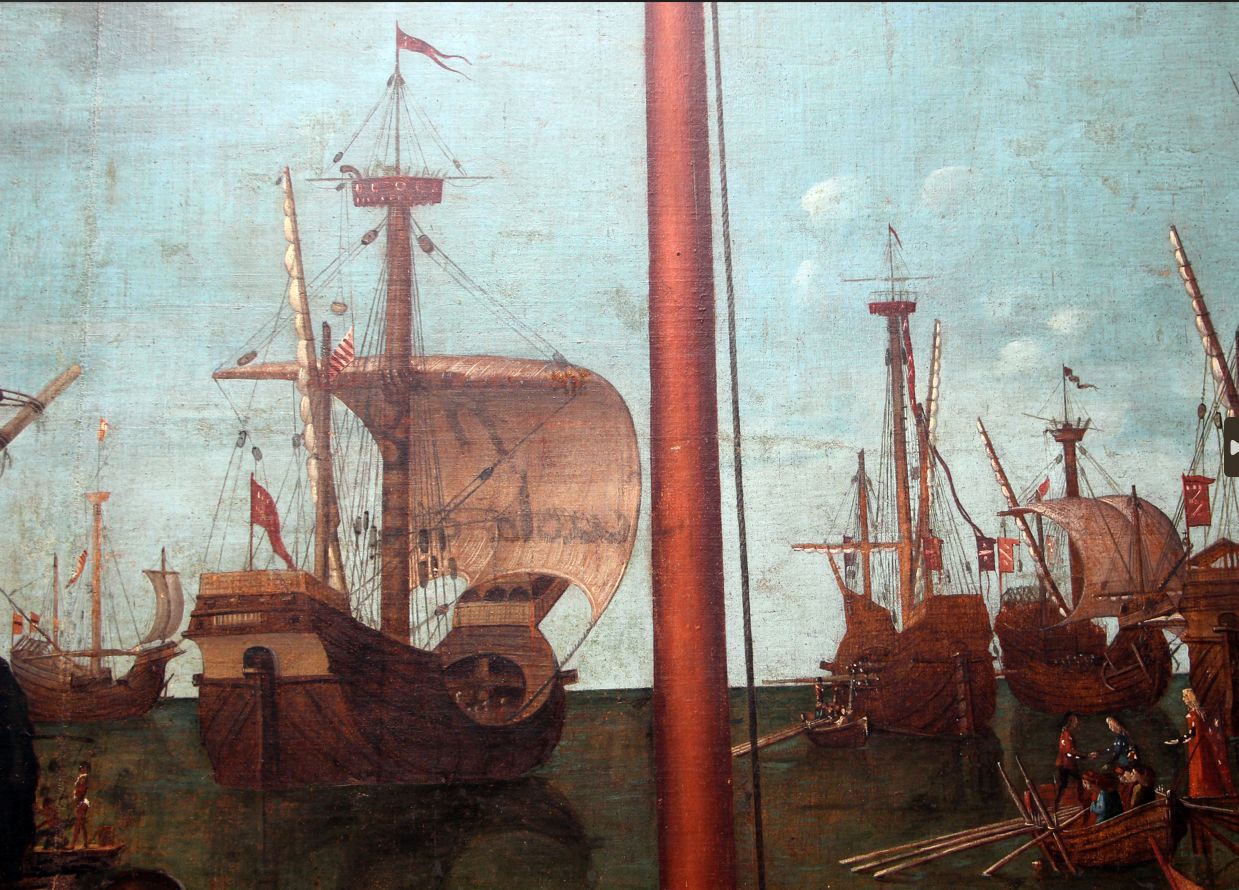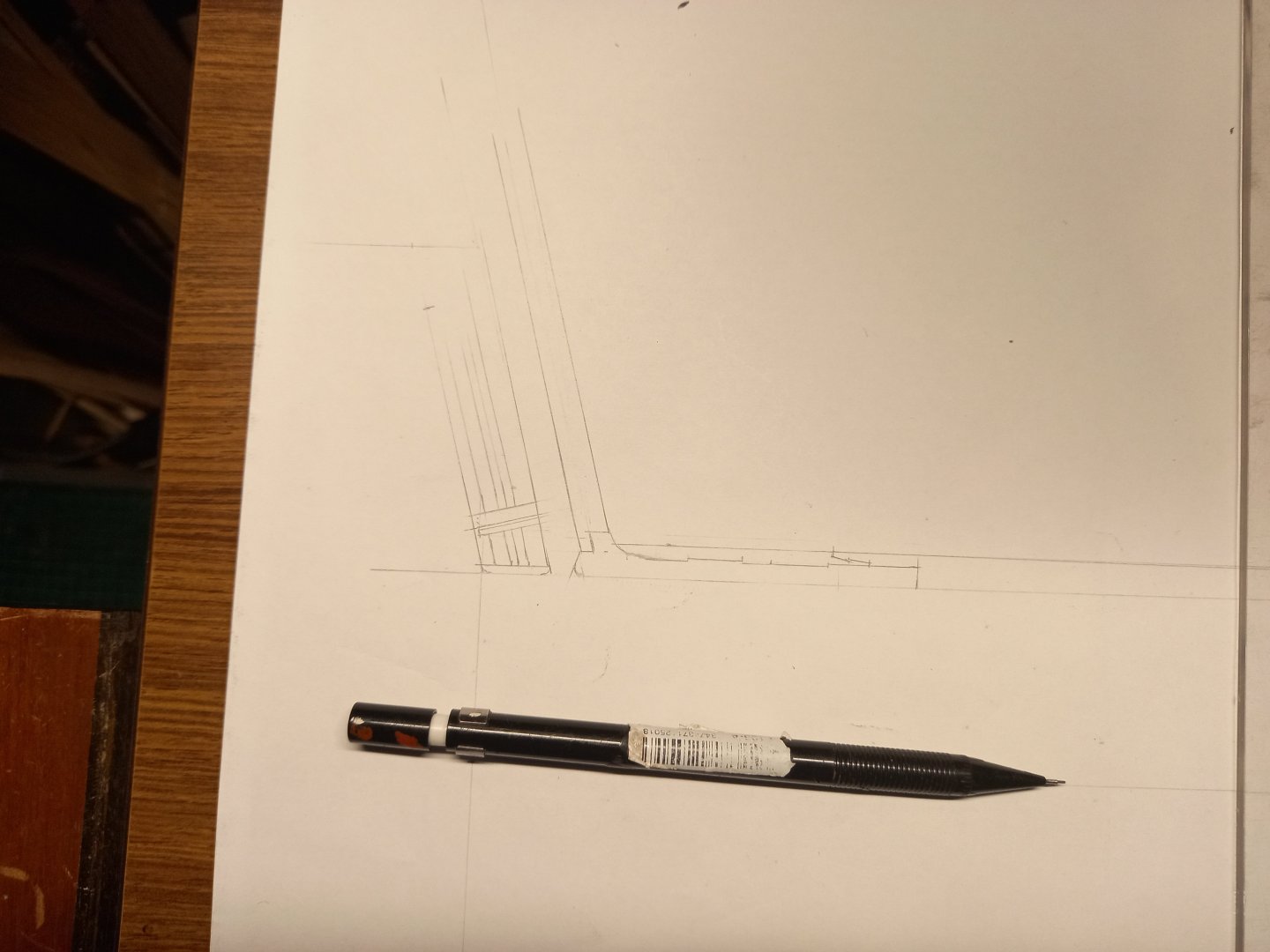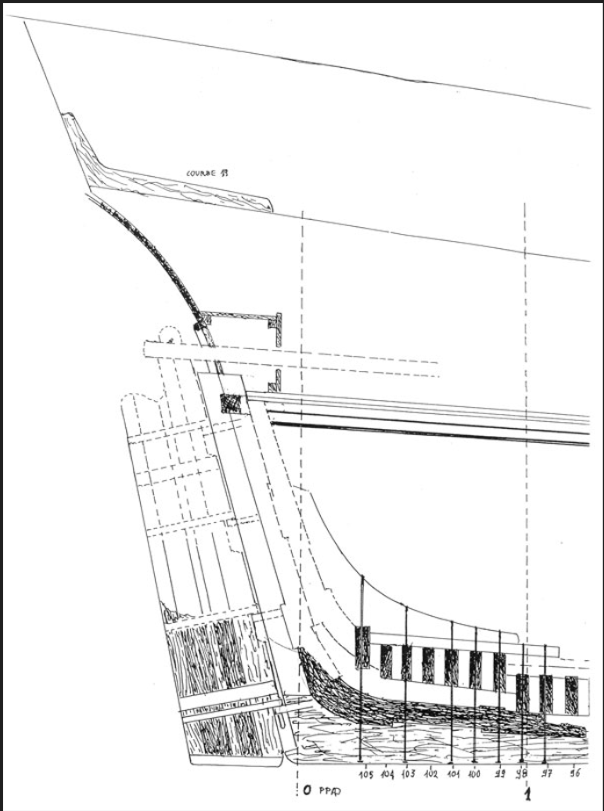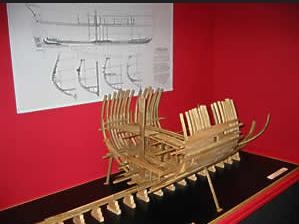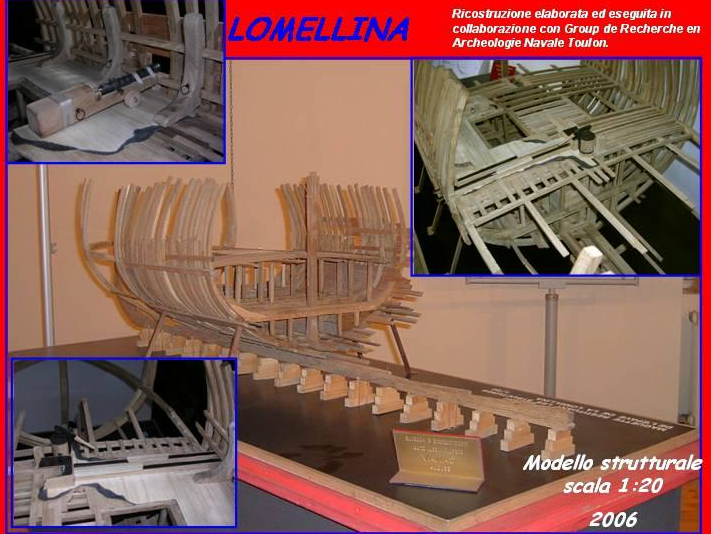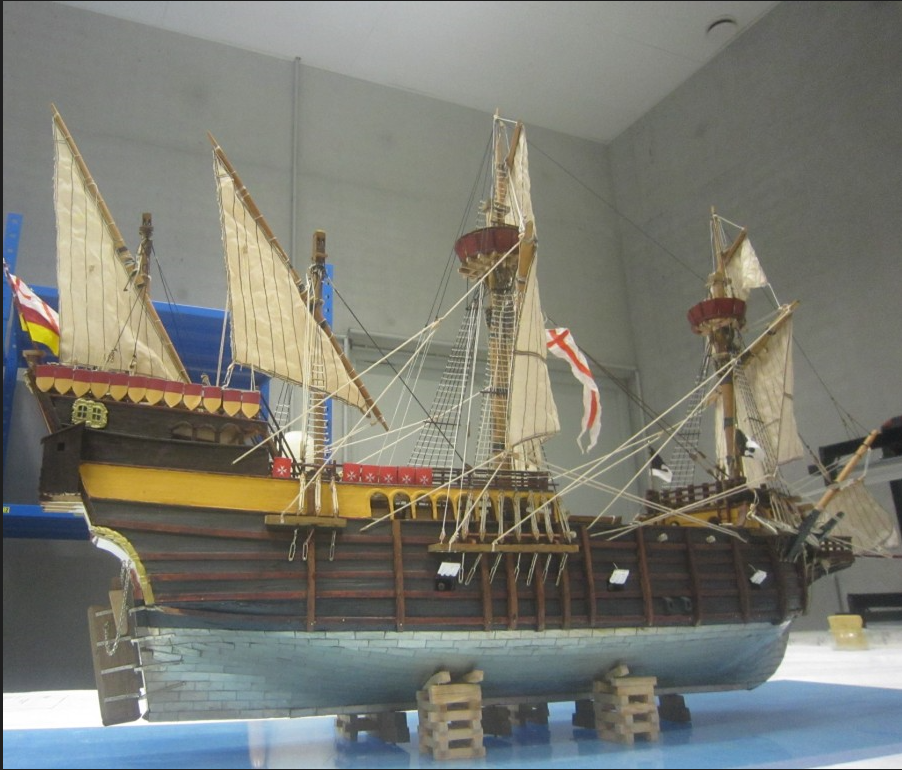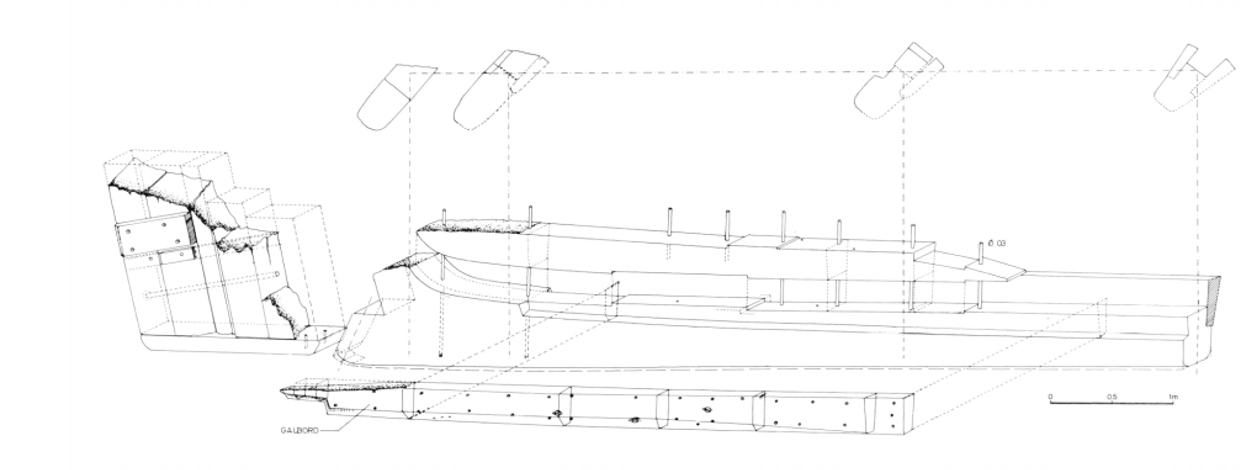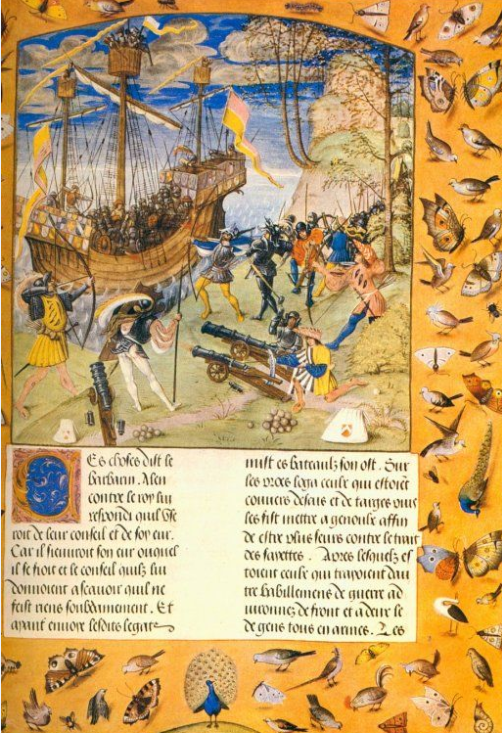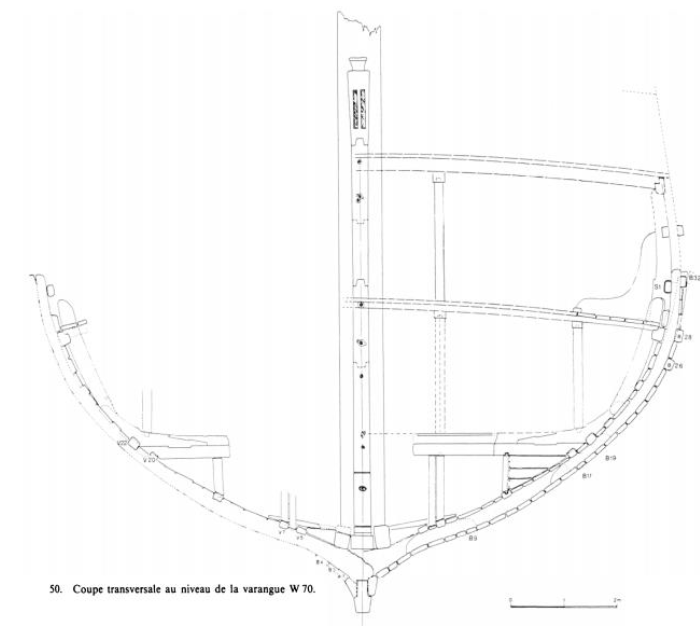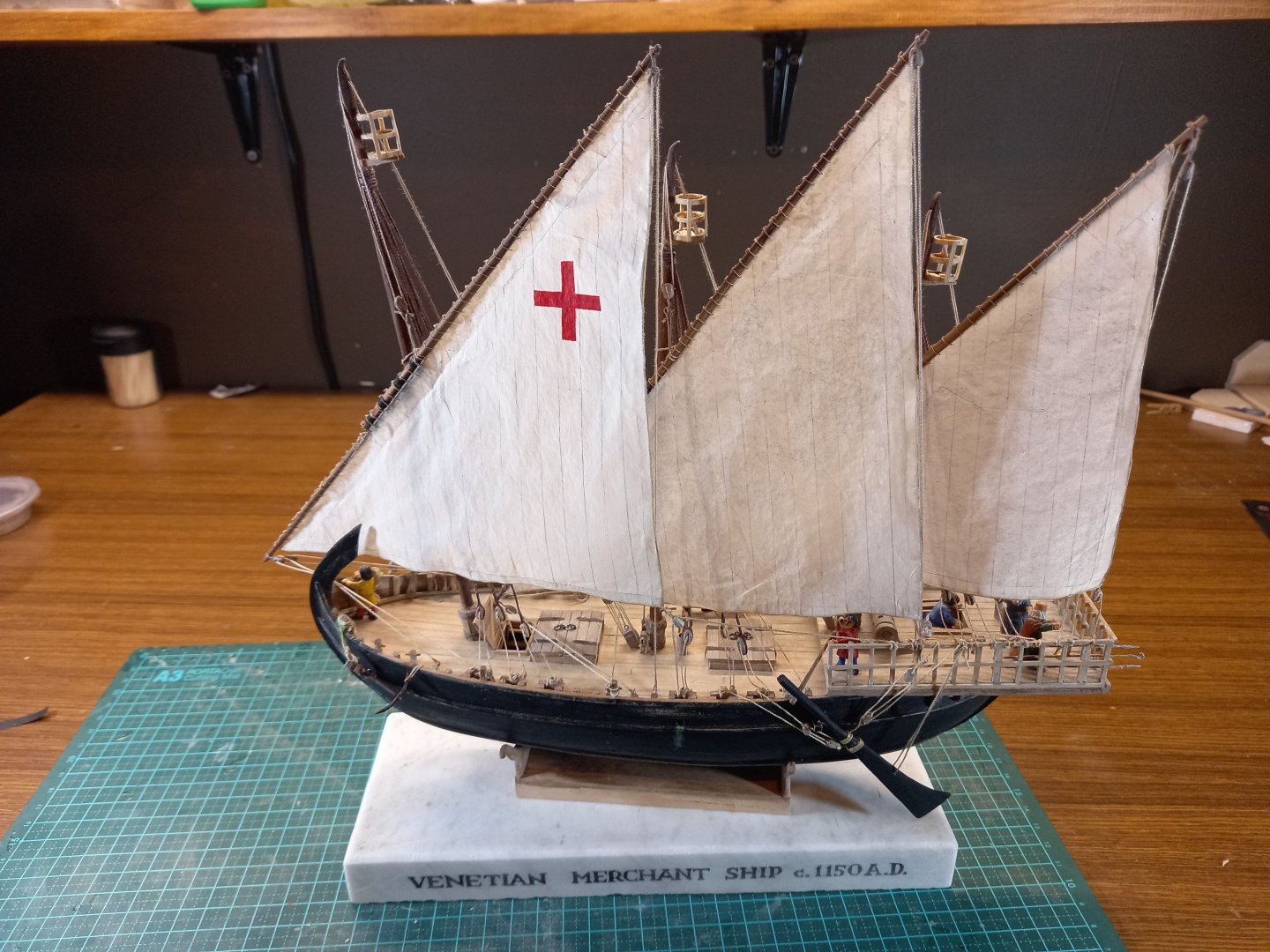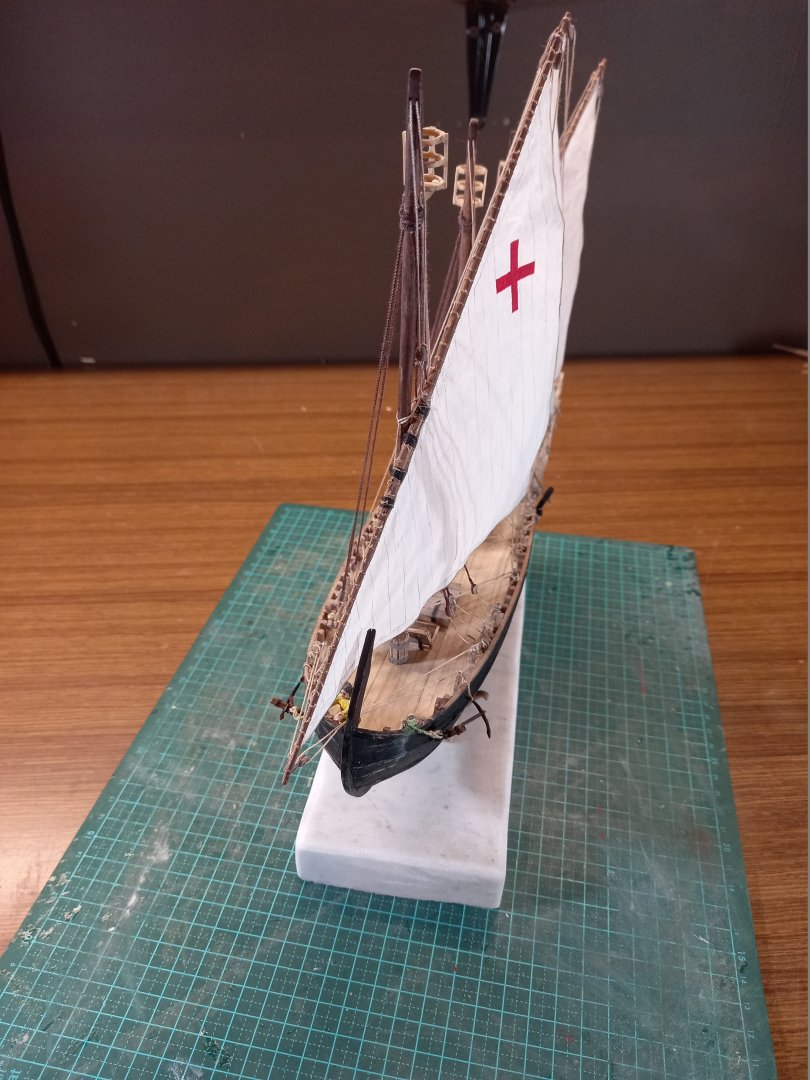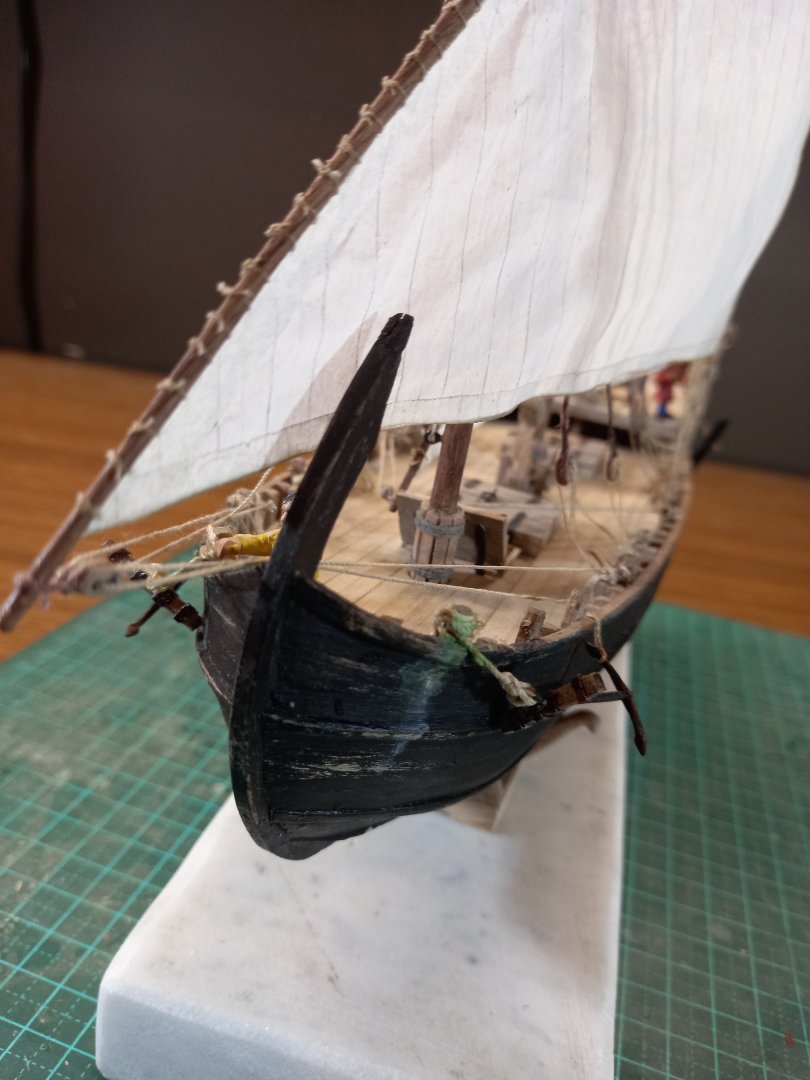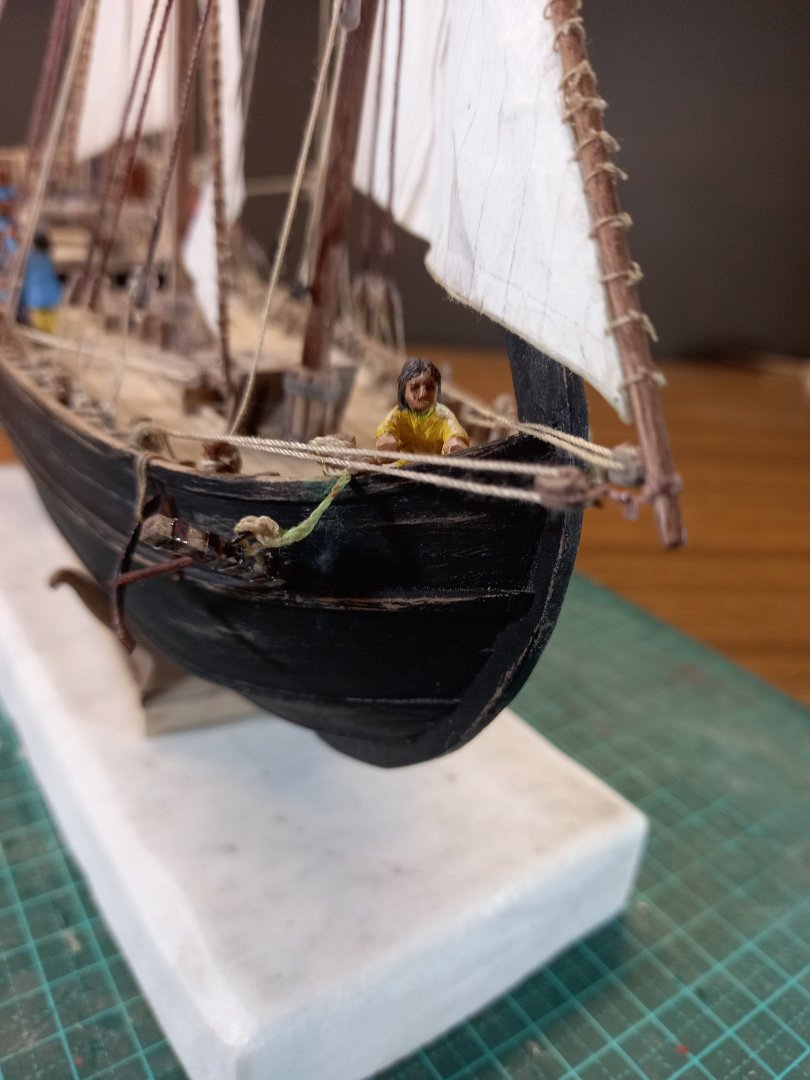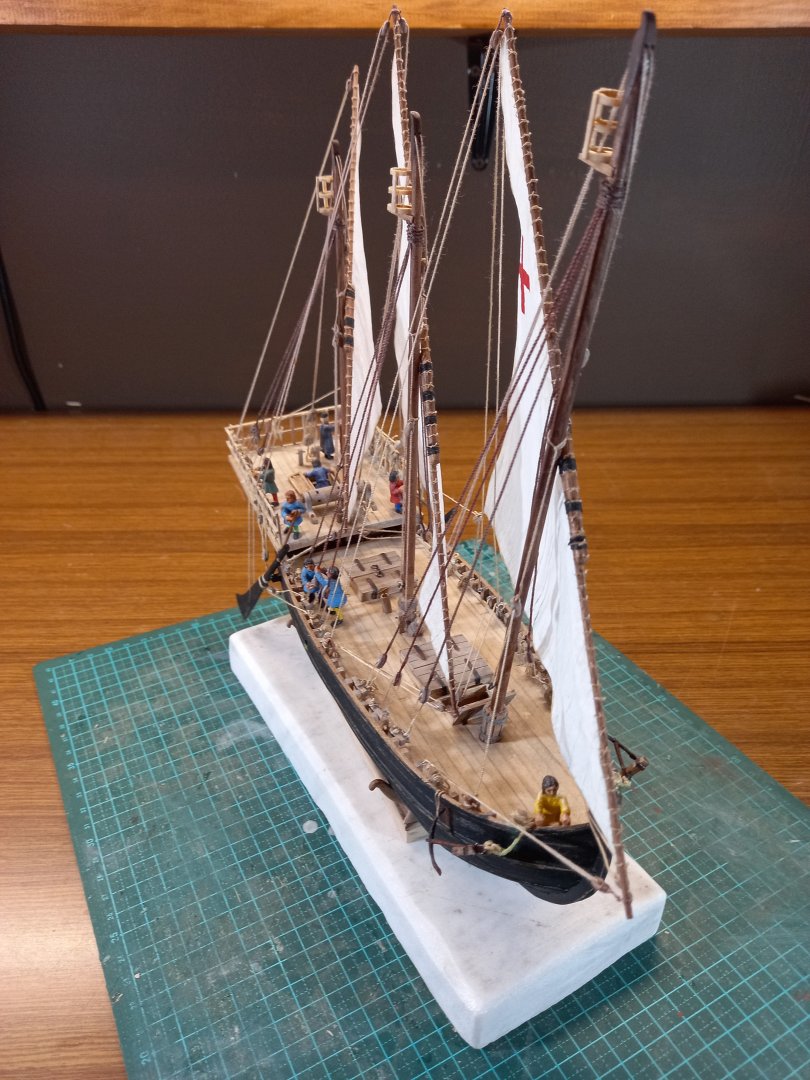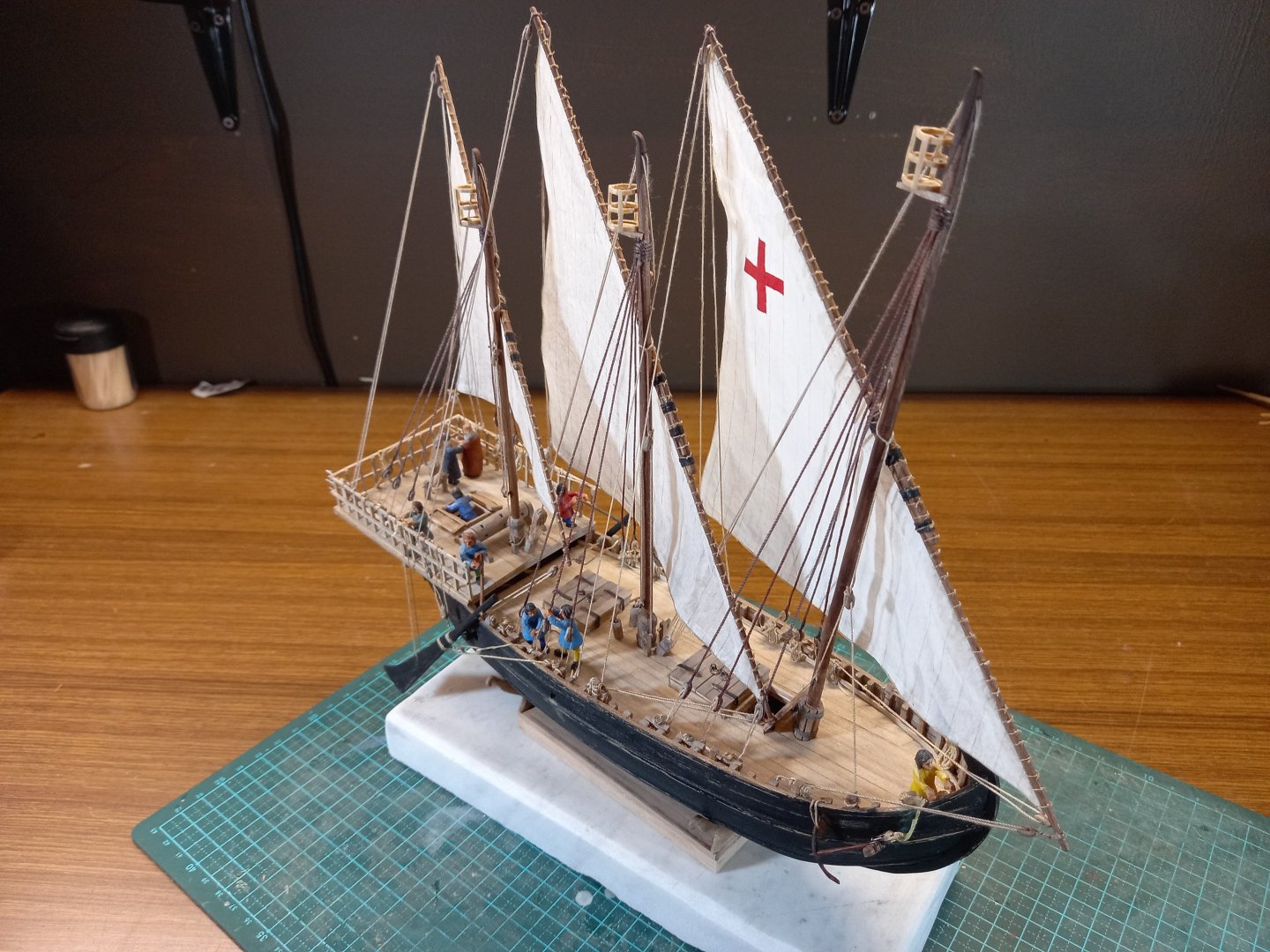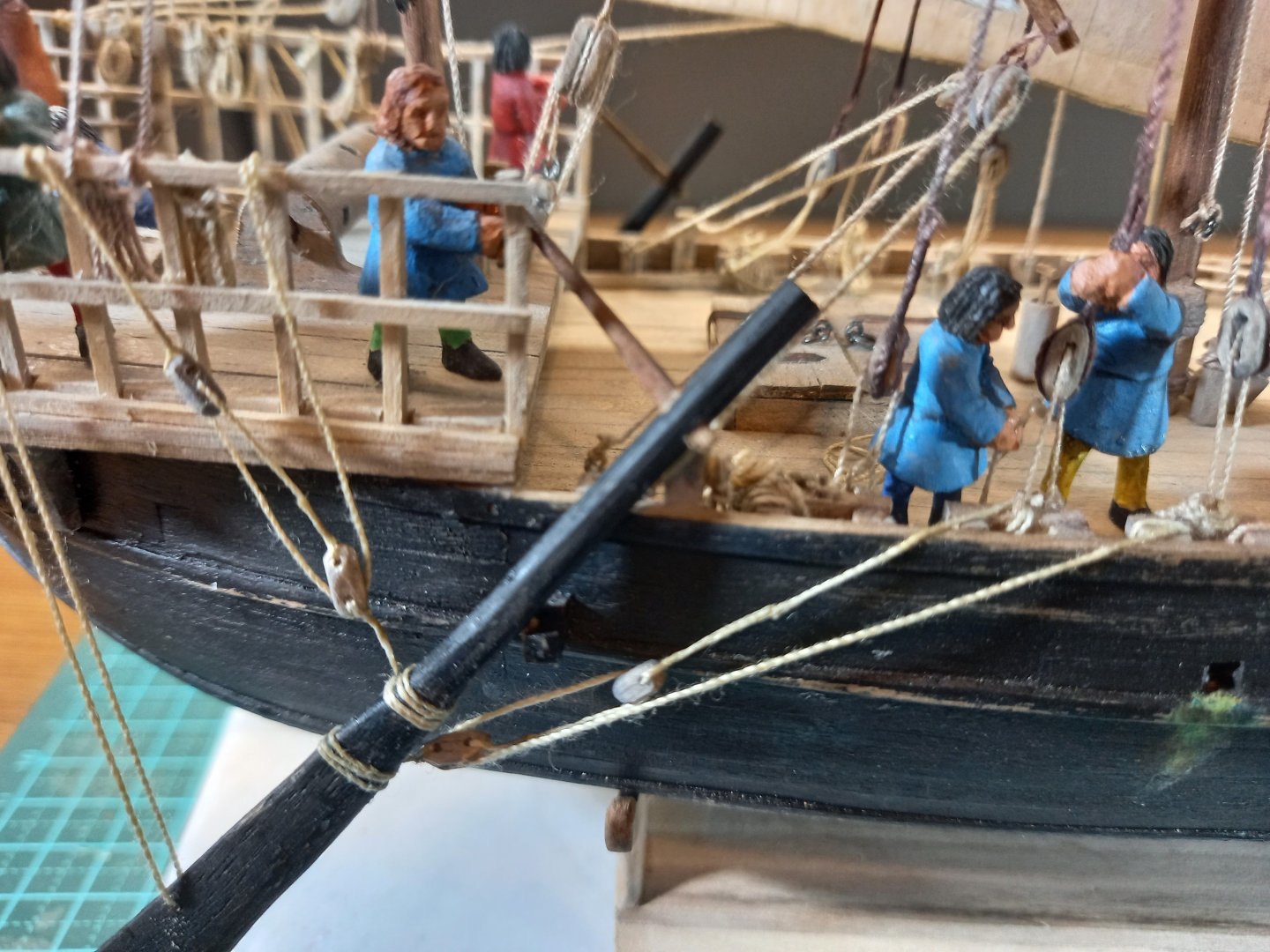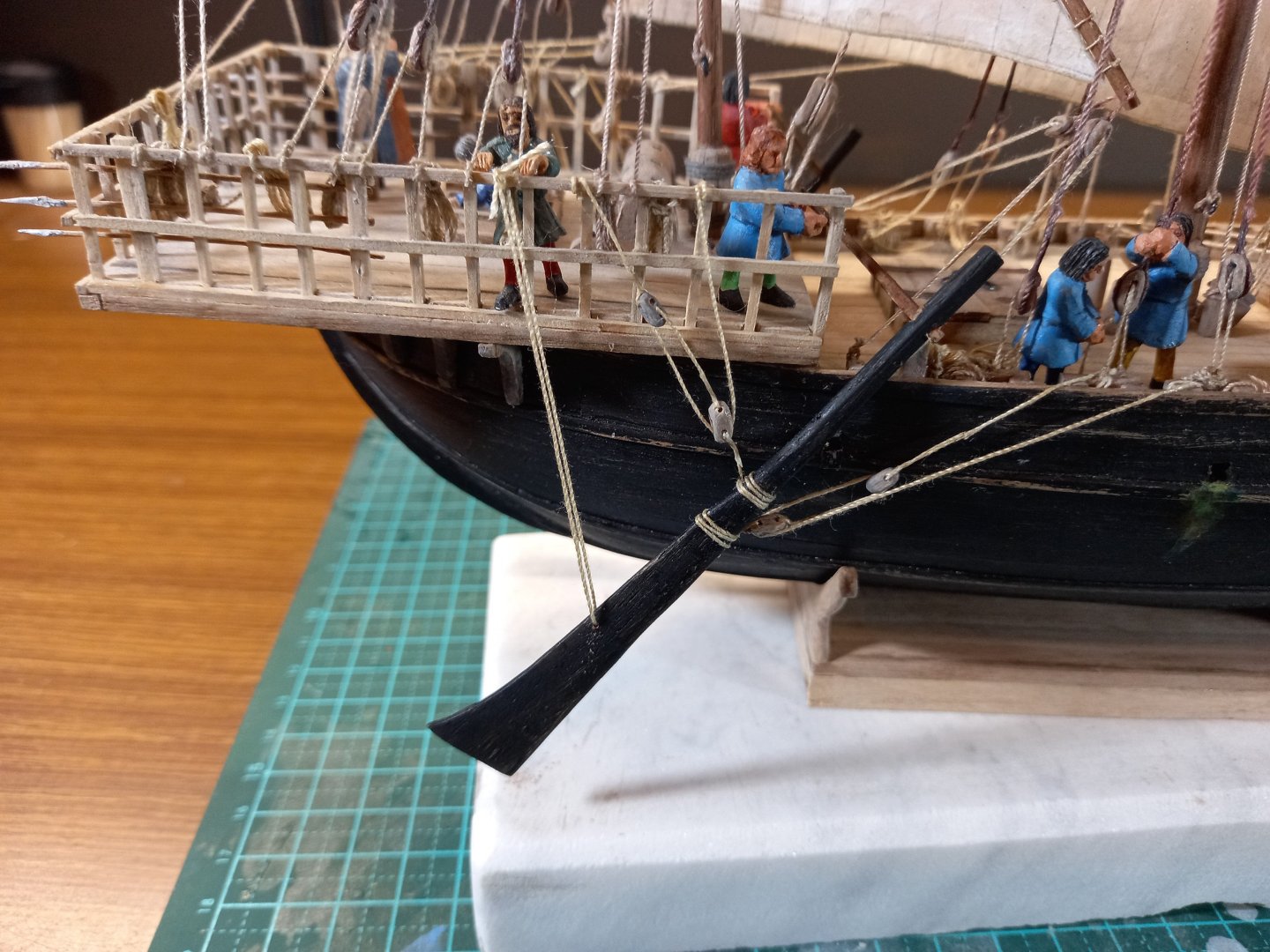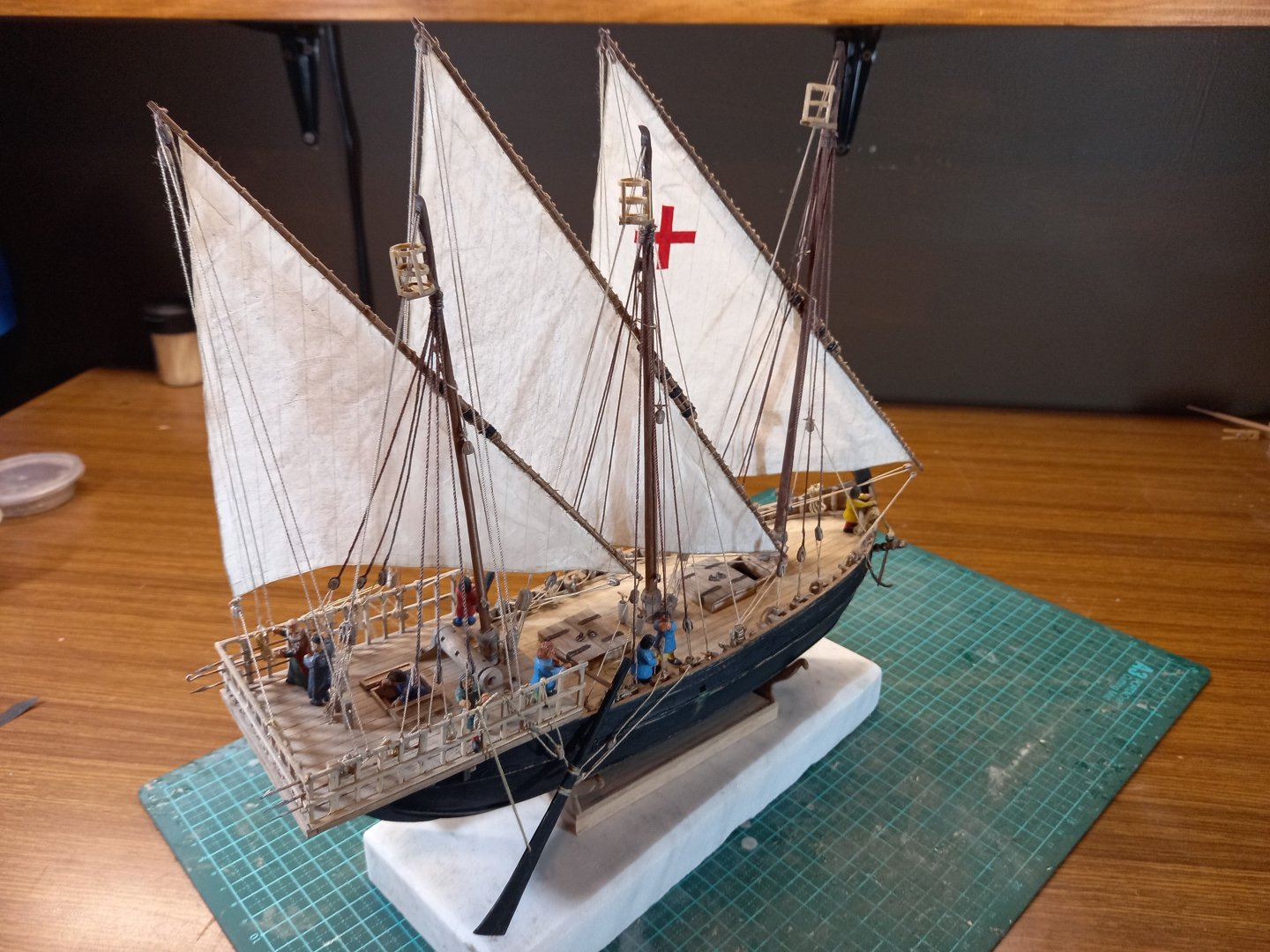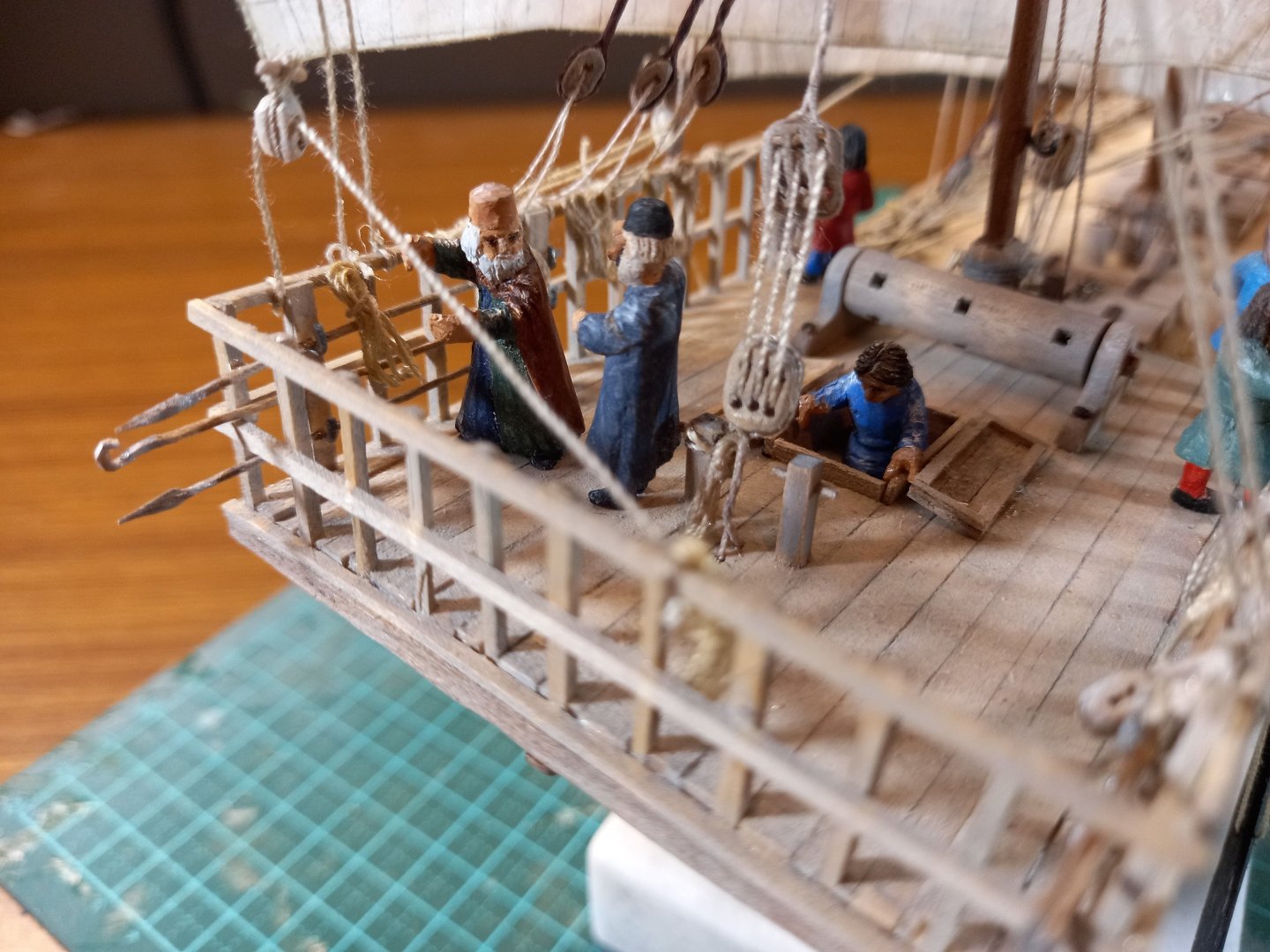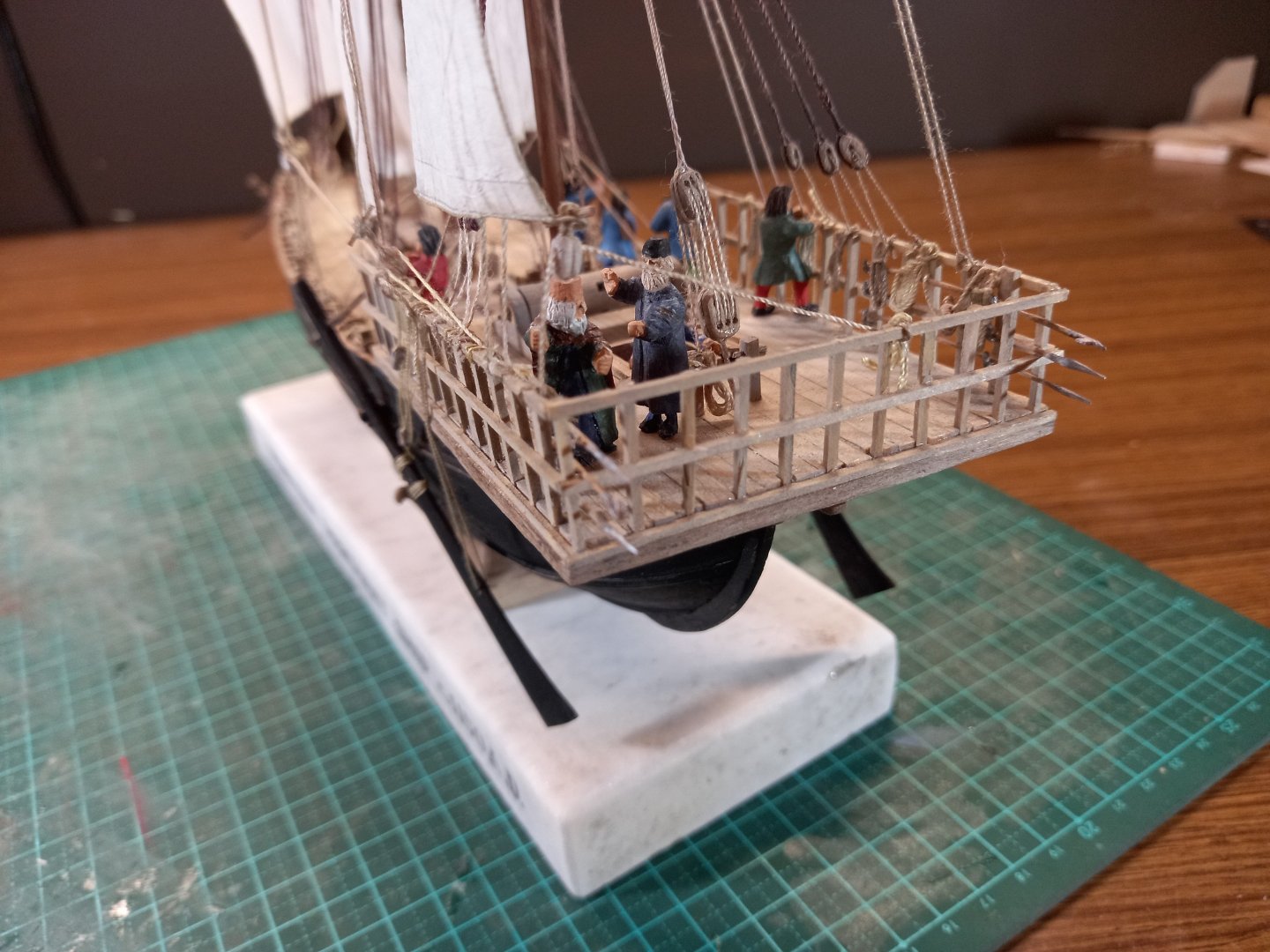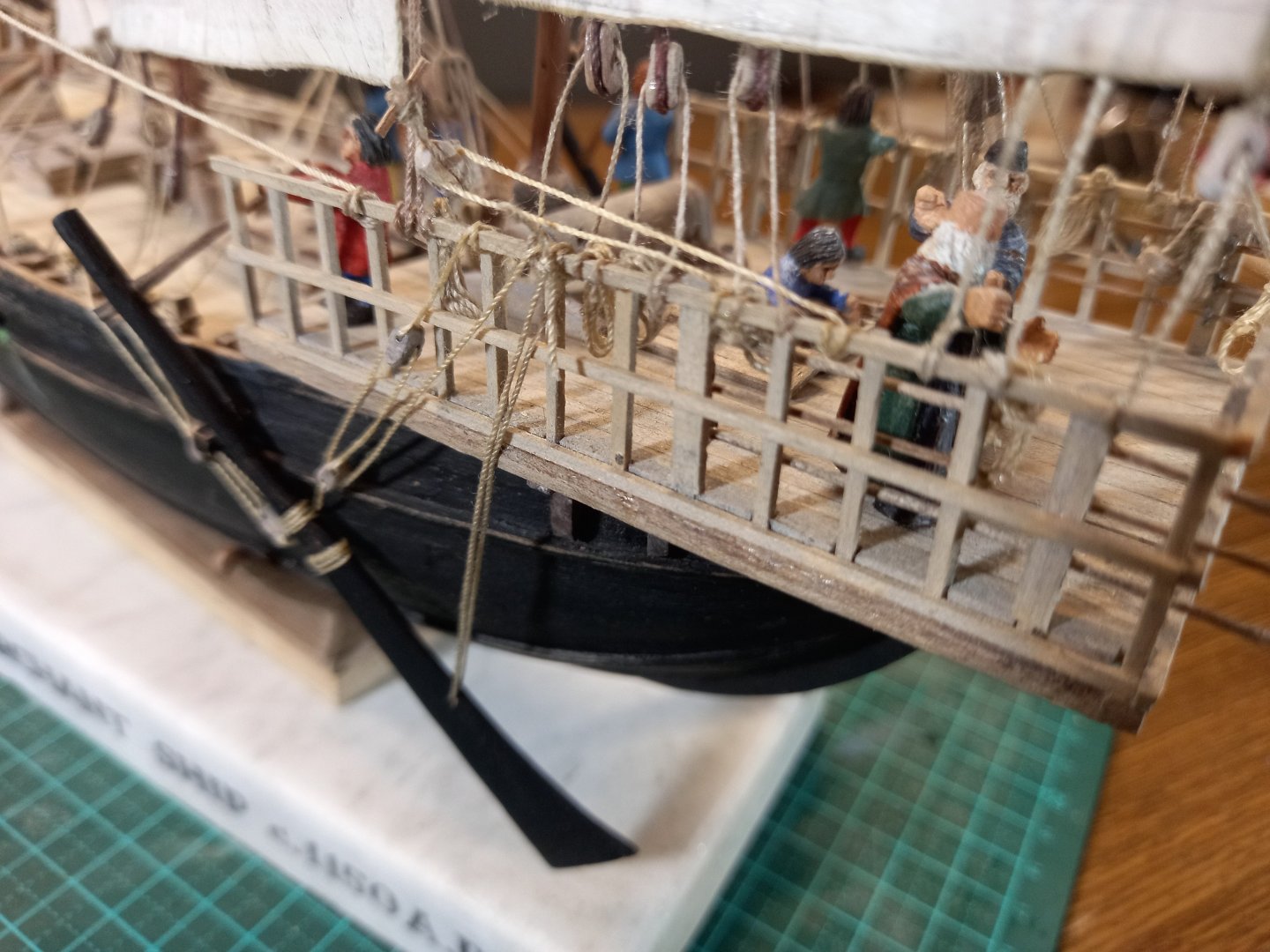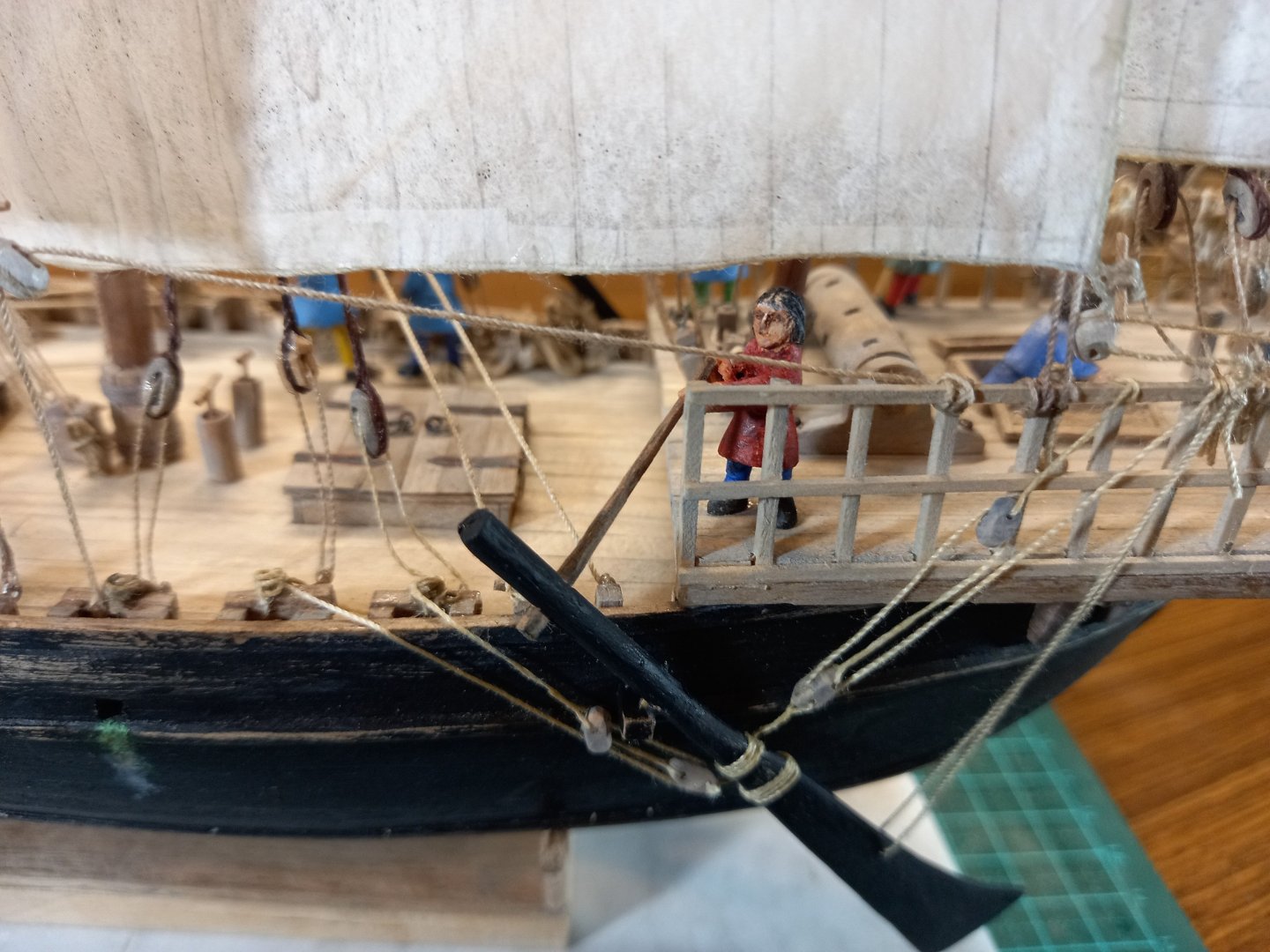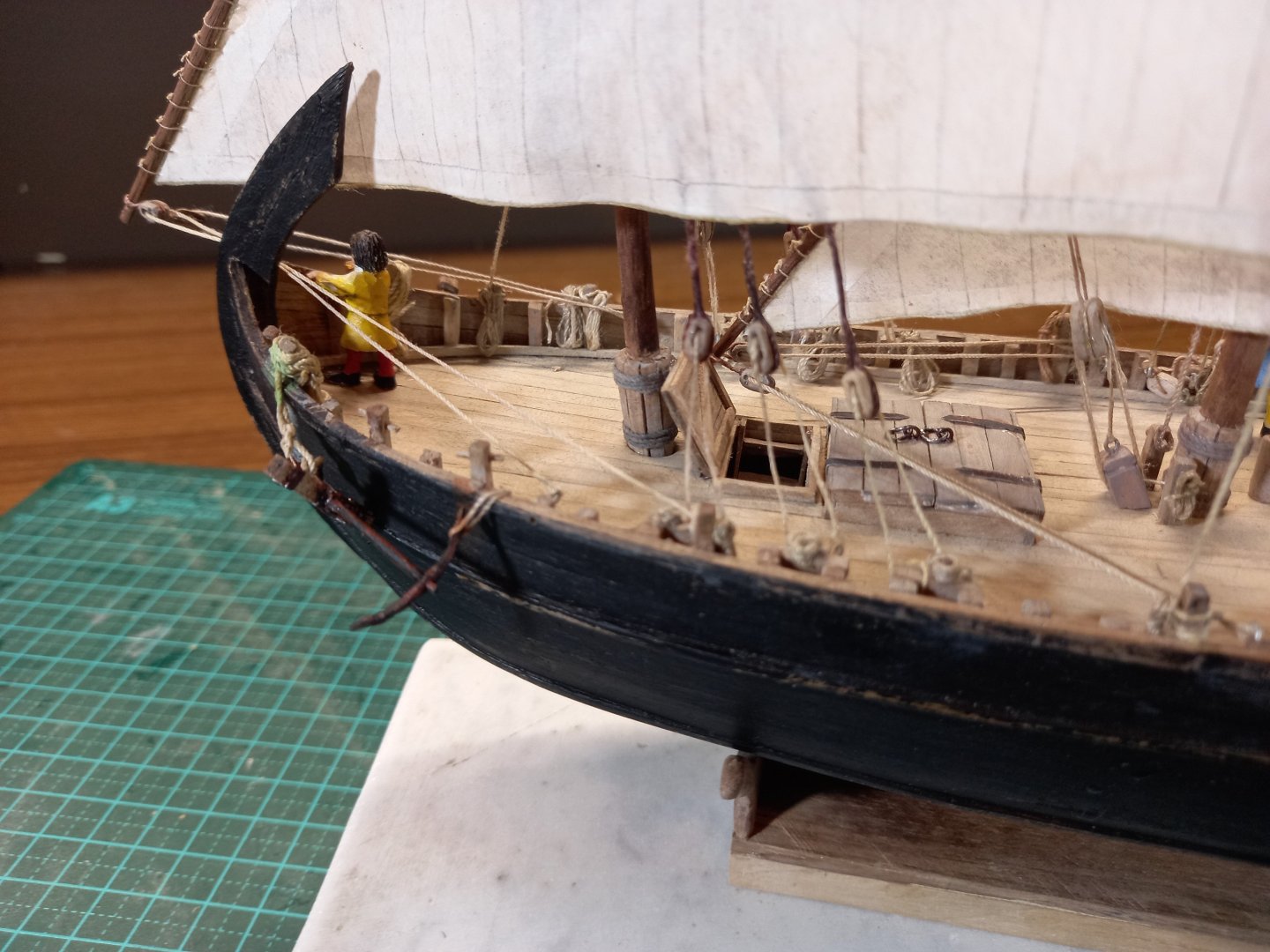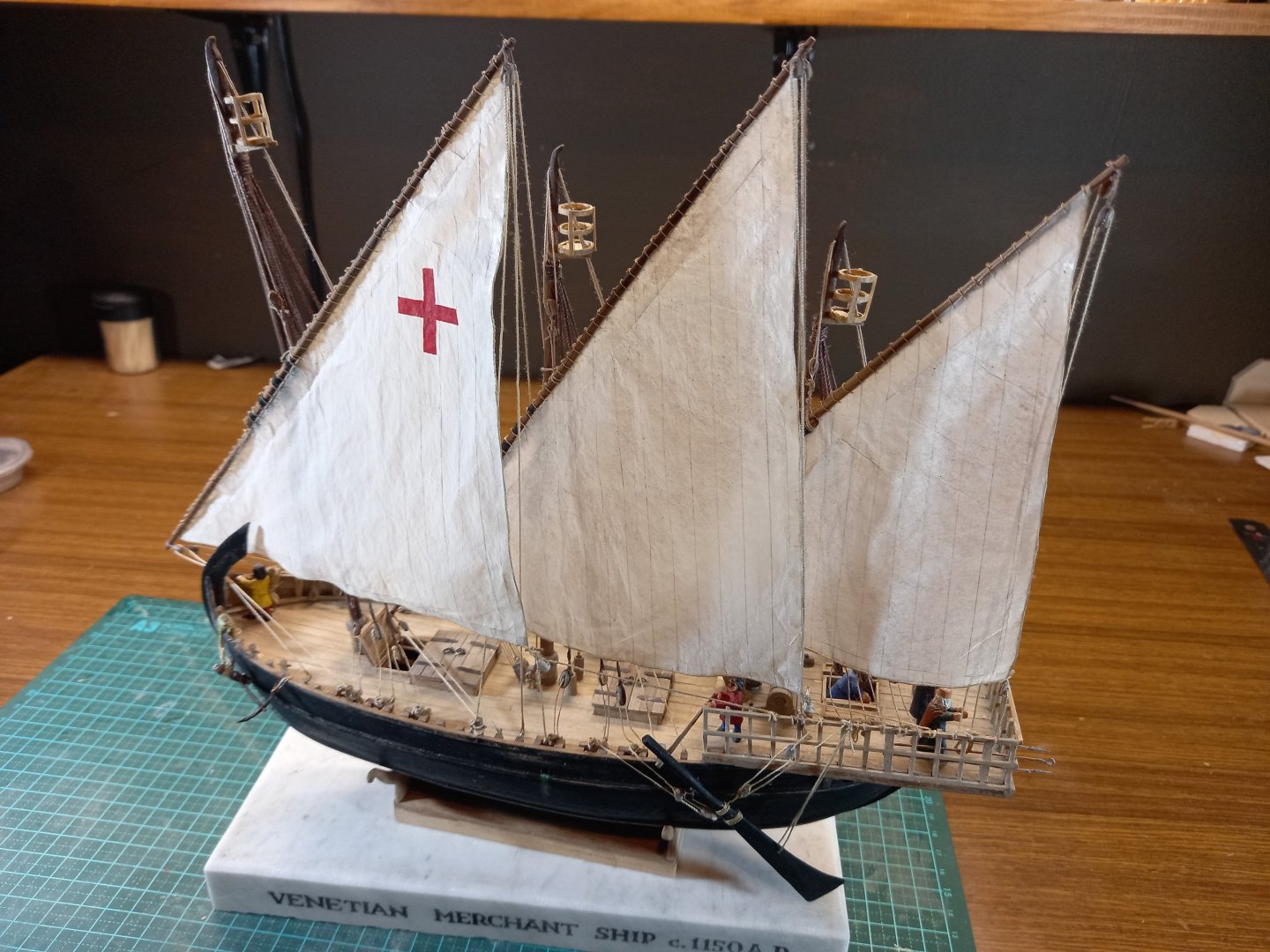-
Posts
7,987 -
Joined
-
Last visited
Content Type
Profiles
Forums
Gallery
Events
Everything posted by Louie da fly
-

Orks Dakka Jet by RGL - FINISHED - Warhammer
Louie da fly replied to RGL's topic in Non-ship/categorised builds
Good grief! Steven -
Johnny, yes I agree. And yes, some have shields attached to a higher rail. If you look at the very first picture in this thread (don't look too hard, it's loaded with inaccuracies!) you can see that 'Lomellina I' has them on the forecastle and aftercastle, and I'm thinking seriously about following suit with her younger sister. The flags belong to the Lomellini family, but perhaps the shield designs are those of the men-at-arms on board. And does the ship carry those shields when not expecting to be in combat? Who knows? Steven
-
Ferrus, this is an issue I'm very aware of, and in fact I've been arguing the point for over 10 years. See . Regarding the museum model, I'm not taking any notice of it at all. It's wrong in so many ways - I don't like to criticise , but the guy who built it had no idea of the configuration of a carrack. I've been reading through the latest paper on the shape of Lomellina's hull (see link in post #17 above). Here's what is known from the archaeological results (with a bit of tweaking of frame shapes to allow for the fact that the shape would have been deformed by the weight of the overburden of silt). They recorded 12 cross-sections, 8 of the "surviving" frames - that reached all the way to the keel (CS 6 to CS 12 also referred to as S6 to S12), 4 of partially existing frames (CS 2 to CS 5). Here are the results. Though I'm prepared to accept their research data I do have reservations about their conclusions as to the lines of the hull. If you're interested you can see them in the paper linked in post #17 above. So I'll 'go off on my own' and see if I can't work out a set of lines I'm happier with, that fit in better with what I know of the shapes of carracks from contemporary representations, particularly those of Carpaccio and Botticelli (see pics in earlier posts). Steven
-
You're quite right, and I hadn't been figuring the height of the gun pedestals into the equation. Thanks. And in fact, zooming in on the Zumia picture the guns do seem to be up off the gunwale (OTOH, the first of the Beauchamp Pageant pics shows the barrels resting directly on it). And I've found another pic with 2 normal sized people up against the gunwale. "1486 Pilgrim Book by Breidenbach. Ship building in Venice" The guy on the right seems to have it coming up only to his hips, while the other has it up to his chest. The second guy seems to be painting the side of the hull, though, and I believe he might be kneeling down to do it without overbalancing. All of this inclines me to accept a lower gunwale height - possibly even less than 1.2 metres. The legal requirement for balustrades on balconies (at least here in Oz) is 1.0 metres - to stop people tipping over the edge and falling. I'd say that would be my absolute minimum height for the gunwale. Getting there . . . Steven
-
Thanks everybody for the likes and comments. Early stage at the moment. I'm currently thinking about the height of the gunwales to the weather deck. As well as the 'theoretical' height in the cross-sectional view in my first post, there are a few contemporary pictures which I'm hoping will help. There's this image from the so-called Beauchamp Pageant (Cotton MS Julius E IV), but that's not a lot of help, as the human figures are obviously over sized (as was usual at the time). There are VERY few contemporary pictures that accurately show human figures at the correct scale. This one from the same source is not high resolution, but I believe the scale of the figures is probably about right - The picture of the Battle of Zonchio (1499) shows the gunwale as being almost shoulder height But there's a detail from Carpaccio's Ursula Legend that seems to show the gunwale coming up to about people's waists. Then there's this one from 1493 that seems to show the same. This one of Columbus' ship from the 1502 Libre de Consolat dels fets maritims Barcelona shows it about middle of the chest - Then there's this one from Zeiriksee in the Netherlands of 1506, showing it nearer the waists of the human figures. And from Jonah by Bellano Basilica of San Antonio, Padua, 1514 - chest height. As Lomellina was Genoese, I'd be inclined to follow Italian images for preference. And it needs to be borne in mind that the gunwales are just that - wales that were the base for (swivel) guns. So they should be somewhere above waist level for the gunner but below shoulder level. So, assuming an average height for this time and place of perhaps 5'6" (1.68 metres), I'd be looking at between 1.2 metres (about 4 feet) and 1.3 metres (approx 4'3"). Returning to the issue of masts, there could possibly be one or two mizzens. A votive table of 1475 of the parish of San Pedro de Zumaia in Spain, commemorating a battle between Spanish and Portuguese forces, shows the largest ship with a mizzen, and a bonaventure mizzen behind it. And a detail of a panorama of Venice of 1500 by Barbari shows a similar thing on a merchant ship. However, the great majority have only a single mizzen. Is the Lomellina big enough to warrant two? She was certainly pretty big for the time, bit I'll have to think about it. Steven
-
Thanks everybody for the likes and comments. It's nice to have finished the build and though I'm painfully aware of places where I didn't get it as right as I'd have liked to, I'm actually very happy with this. MikkiC, I've already started work on plans for the next one - see It'll be a while before I start making sawdust, but the design process is under way. Steven
- 508 replies
-
Still figuring out the plans. I've now got a pretty good idea of the lines of the main and lower decks and the orlop, the configuration and position of the stempost (awaiting confirmation from France!), and the location of the mainmast, the halyard knight and the capstan, plus where on the keel the 12 cross-section views were taken. Still a bit up in the air, but I believe I'm on the right track. And she's starting to look rather pretty! Though there's no archaeological evidence of a foremast or mizzen - they would both have been relatively small and it's unlikely they'd have been stepped on the keel - I am completely certain a ship of this size at this time would have had both. Now I'm thinking about the height of the bulwarks above the main (weather) deck, and the height, angle and configuration of the forecastle. The Botticelli painting The Judgment of Paris contains a carrack which can be seen, unusually, from above, and it looks like it has a poop deck. Perhaps I'll give the Lomellina one as well. Steven
-
Perzackerly (that's a combination of precisely and exactly). But often the word stands alone and I have to work out the meaning by context, if I can (sigh). I think the Lomellina's bow will also be surprisingly pointed. There's this idea people have that they were tubby, but it seems not to be true, but instead influenced by contemporary artists having trouble accurately showing a ship's bow seen from forrard. And apparently this particular vessel had proportions more like a galleon than a carrack - overall length 46 metres, beam about 12.5. Slim and fast. See https://www.tandfonline.com/doi/full/10.1080/10572414.2023.2186748#d1e2365 - However, that bow shape in the latest iteration is pretty speculative - if you look at the cross sections in this document, you can see that the surviving remains are very thin and a very slight difference in angle of orientation compared to vertical could make a huge difference to the shape of the hull. I'm still investigating all of this - I'd like to make up my own mind about it all, rather than just copy what others have decided - but definitely making progress. I've now drawn the full length of the keel, got the deck heights and drawn the stempost. Not sure about the last - one of my sources seems to suggest that the stempost was found, but that's not backed up by any of the archaeological reports I have in my possession. I'm just going to have to write and ask. Steven
-
Perhaps fairleads? From Merriam-Webster online dictionary: fair·lead or less commonly fairleader ˈfer-ˌlē-dər 1. : a block, ring, or strip of plank with holes that serves as a guide for the running rigging or any ship's rope and keeps it from chafing 2. : a course of running ship's rope that avoids all chafing. Steven
-
Thanks for all the comments and likes. News is that I've been in touch with Max Guérot, and he's sent me the latest reconstruction info, and with that plus having tied down reference points even more firmly (I have the locations of the 12 cross-sections relative to the keel now, AND to the grid lines, for example, plus levels for the decks), I've been able do more work on laying out the side view. Steven
-
I've spent a frustrating evening trying to get a zero point to base my measurements and frame positions on. The archaeological team worked very systematically, dividing the wreck site into a grid of squares 1 metre x 1 metre, starting well aft of the a*se aft end of the wreck and ending well forward of it, so as not to miss anything. The diving season is limited (presumably because of weather), so beginning in 1983 they covered an area of 40 square metres each year, starting at the stern. The after end of the keel is one known point, but the other 'zero' they chose for all other measurements - and in particular, the locations of 12 cross-sections shown in diagrams - was oriented to the outer end of a particular strake, and I couldn't find any way to relate it to the keel. Eventually, in a discussion of the framing, they gave the distance from the after end of the keel to the assumed master frame (or, as in French the word for frame is feminine, the mistress frame), labelled W59. So I now have my reference point, and I can move forward. One thing that becomes plain is that for the time, the Lomellina was BIG. An overall length of something like 46.5 metres (152 feet). The Santa Maria was only 36 metres (117 feet) and the Gribshunden, the Danish royal flagship (which was built around 1486 and sank in 1495) was only 32-35 metres (105 -115 feet). That's all for now, except to show what she would probably have looked like. These ships are from the Ursula Legend series painted by Carpaccio in Venice in 1497-8 (5-6 years before the date I believe the Lomellina was built) and presumably depict typical Venetian carracks of the time. Although there were differences in construction between Venetian and Genoese vessels, they would have been very much like this. Steven
-
Little steps, little steps. Here is as far as I've got with the drawings - the aftermost piece of the keel, plus the rising wood attached to the top of it, plus the notional (because missing) sternpost, plus what remains of the rudder, in the process of being creatively reconstructed into a full rudder. Which I'm now having to look at contemporary pictures of carracks to get an idea of, because I don't agree with their interpretation as shown in the diagram in the previous post. This has taken me two or three days of struggling over (and bit by bit correcting) two or three pages of a Google translated archaeological report, interpreting it as an image from the diagram and the descriptions, and turning it into a 1:100 scaled drawing. It's all fun and games till someone loses an eye . . .
-
Thanks everybody for the likes and comments. Just a quick point to start with. That diagram of the keel assembly wasn't done by me - it was from the published archaeological report, kindly sent to me by Dr Max Guérot, the leader of the archaeological expedition that uncovered the Lomellina, along with many many other reports and references to other wrecks that he sent me. He has been very generous and I'm very grateful indeed for all his selfless help. I've just emailed him to let him know I've finally started - it's a little embarrassing - it's been more than four years since we've been in contact and he'd probably given up on me. Anyhow, things are finally starting to move, albeit slowly. One thing I'm beginning to realise is that I'd been a little over-confident about how much of the ship survived to act as a reference for my reconstruction. There's certainly a lot less than, for example, the Mary Rose. Here's a model that was made of what does survive. But on the other hand, there's quite a bit to work with - we have a fair bit of the keel, quite a bit of framing and planking, part of the rudder, guns (with carriages!) and even a gunport lid, for heaven's sake! And lead sheathing on the underwater hull! No forecastle, unfortunately (dammit!) But I'm pretty confident I can get something worthwhile out of what's available and fill the gaps from contemporary images, particularly the superb Ursula Legend paintings by Carpaccio, dating to maybe a decade before the Lomellina was built. Venetian rather than Genoese, and I'm aware there were differences in construction between the ships of the two city-states, but in general, a good guide. Woodrat, I'll probably be availing myself of your generous offer of help with traduire, and yes, I'm planning on a round tuck - all carracks of this period seem to have them, and the theoretical reconstruction drawings from the dig show one - - and anyway, the earliest evidence for a flat stern on a carrack that I'm aware of is 1511. By the way, looking back at the manuscript illustration of the first Lomellina, above - I will only be taking from that what I believe to be relevant - it's of an earlier ship and the artist doesn't seem to have understood ships very well. I've been drawing the keel assembly based on the archaeological report, and to be honest I may have trouble duplicating the carpentry of the scarph joints at 1:100 - I'm just not that precise at woodwork. I expect I'll have to rationalise and simplify somewhat. And I'm not planning on duplicating every aspect of the vessel, particularly not the more complex inner construction details. That way lies madness. But it will certainly be more historically accurate for the period than the one that was made by a model-maker in the early 1990's supposedly showing how she was - maybe half a century too late, and wrong in so many ways. Steven
-
Well, I've made a beginning on drawing the hull, using the dimensions and diagrams in the original archaeological reports. Unfortunately for me, these are in French, and technical French at that. The main report, not including the Annex, is 162 pages long, though that does include things like the coins and pottery found on board, which doesn't concern me (except that these things helped the archaeologists to date the find). I used Google Translate to help, as my French is not up to the whole job, as well as an on-line French-English maritime dictionary that seems to be from the 19th century. But when you have words with several meanings - à means both 'at' and 'to', bâtiment means both 'building' and 'ship', pont means both 'bridge' and 'deck' . . . you see the problem. I'm struggling through it, and I've started drawing the surviving pieces of the keel, rudder, rising wood and garboard . . . It's going to take awhile, and as you can see by the picture of the surviving hull in the first post there'll have to be a fair bit of educated guesswork in supplying the (many) missing bits. Fortunately a fair bit of the theoretical work has already been carried out, so it's not as bad as it first appears. I have obtained the length of keel, overall length, width at the master frame and a few other worthwhile dimensions, which should help a lot. Steven
-
This is the barest beginning of this build log. Very much in the preliminary stage. The Lomellina was a carrack belonging to the Genoese Lomellini family. In 1516, she was hired to the French king who was carrying out a war in Italy. While in the harbour of Villefranche sur Mer on the French southern coast, she was hit by a tempest, capsized and sank. She may have been relatively empty of cargo, which could have contributed to the capsize. Though attempts were made to salvage her, they did not succeed beyond retrieving some of her cargo and armament. She was at least the second vessel of this name - the first was lost in the Greek islands in 1503. I'm assuming that a replacement was undertaken shortly after, so the current vessel was probably built in 1503-1504. Here is a picture (date unknown) of what I believe to be the first Lomellina, judging by the flags she flies (those of the Lomellini family) various details of the ship and the costume and armament shown in the picture. In the 1980s the wreck was investigated over a number of years, and very comprehensive archaeological reports produced. I am basing my reproduction on these reports and contemporary pictures of similar vessels. This is a diagram of the remains - like the Mary Rose, she ended up on her side, so much of her superstructure was preserved. Unfortunately, the forward part did not survive - such things as anchors etc in a working harbour over several centuries destroyed that part of the ship. My first job is to prepare drawings, which will take a while. Though they have a good idea of her overall length and breadth, and several cross-sections, there is still a lot to be worked out. Steven
-
Thanks everybody. I'm still working on the Ballarat paddlesteamer Golden City, but my next project will be a Genoese carrack, based on archaeological reports of a vessel named the Lomellina which sank in the southern French harbour of Villefranche-sur-Mer in 1516 and was investigated in the 1980's. It will be at a scale of 1:100. Steven
- 508 replies
-
- 508 replies
About us
Modelshipworld - Advancing Ship Modeling through Research
SSL Secured
Your security is important for us so this Website is SSL-Secured
NRG Mailing Address
Nautical Research Guild
237 South Lincoln Street
Westmont IL, 60559-1917
Model Ship World ® and the MSW logo are Registered Trademarks, and belong to the Nautical Research Guild (United States Patent and Trademark Office: No. 6,929,264 & No. 6,929,274, registered Dec. 20, 2022)
Helpful Links
About the NRG
If you enjoy building ship models that are historically accurate as well as beautiful, then The Nautical Research Guild (NRG) is just right for you.
The Guild is a non-profit educational organization whose mission is to “Advance Ship Modeling Through Research”. We provide support to our members in their efforts to raise the quality of their model ships.
The Nautical Research Guild has published our world-renowned quarterly magazine, The Nautical Research Journal, since 1955. The pages of the Journal are full of articles by accomplished ship modelers who show you how they create those exquisite details on their models, and by maritime historians who show you the correct details to build. The Journal is available in both print and digital editions. Go to the NRG web site (www.thenrg.org) to download a complimentary digital copy of the Journal. The NRG also publishes plan sets, books and compilations of back issues of the Journal and the former Ships in Scale and Model Ship Builder magazines.




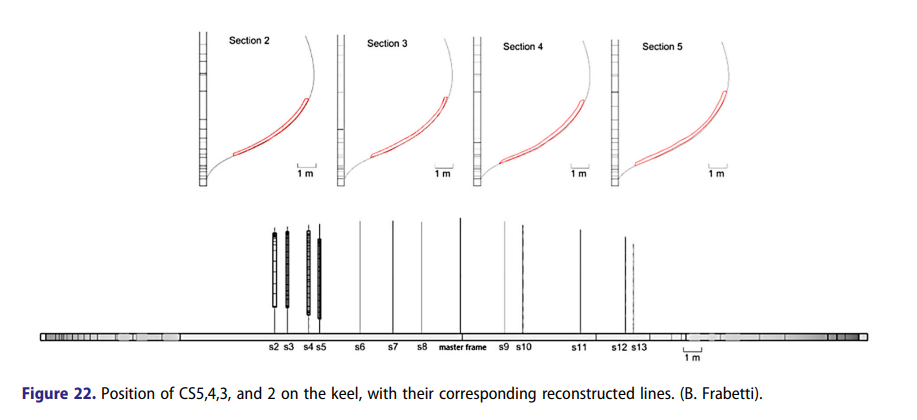

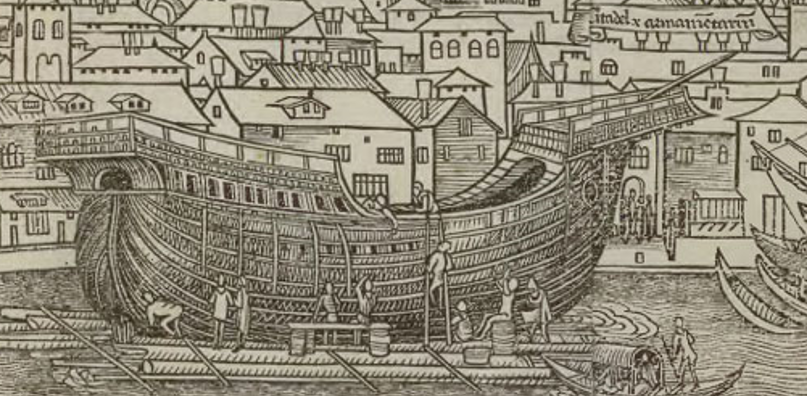
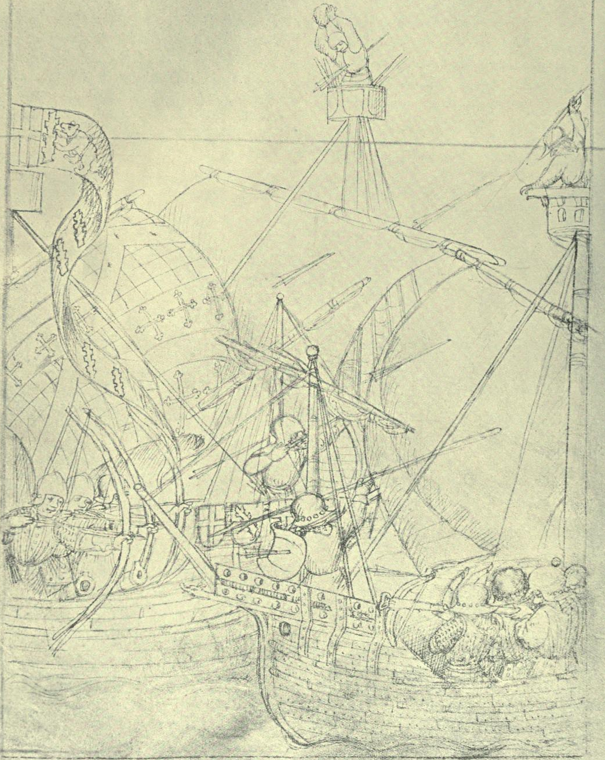
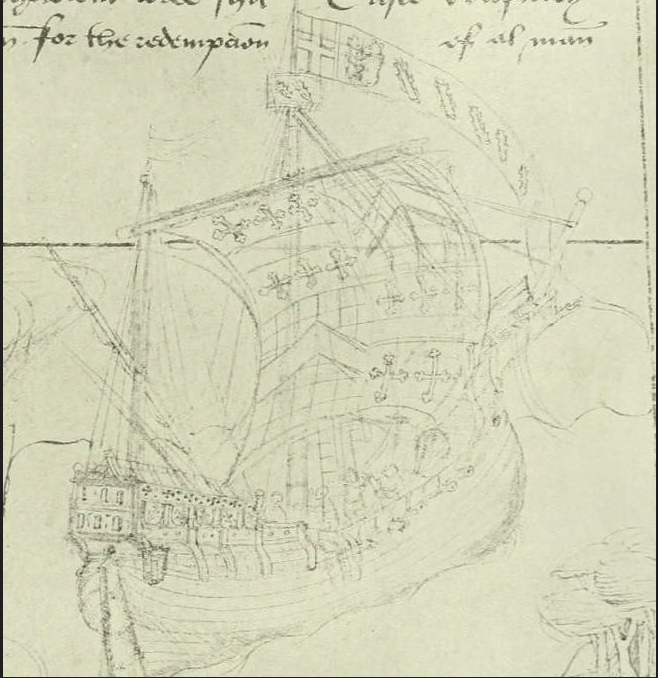

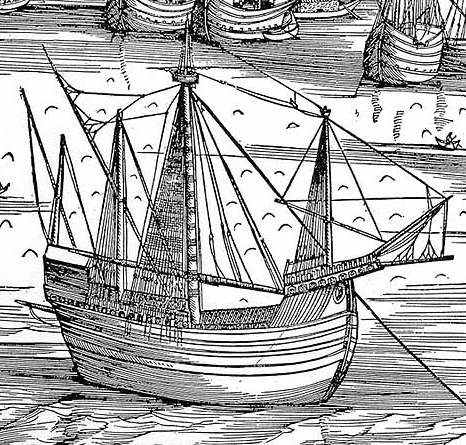
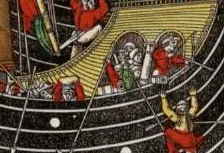
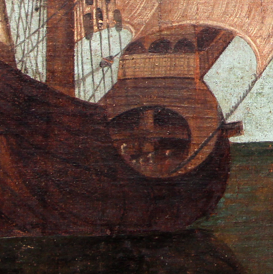
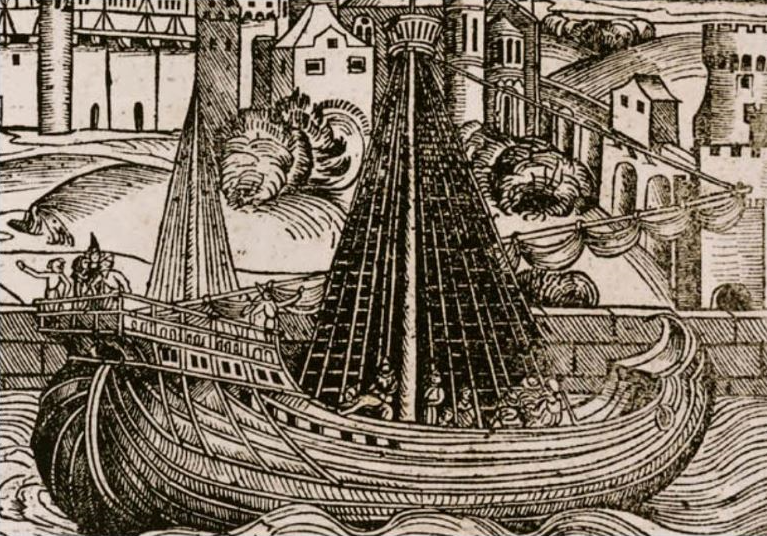
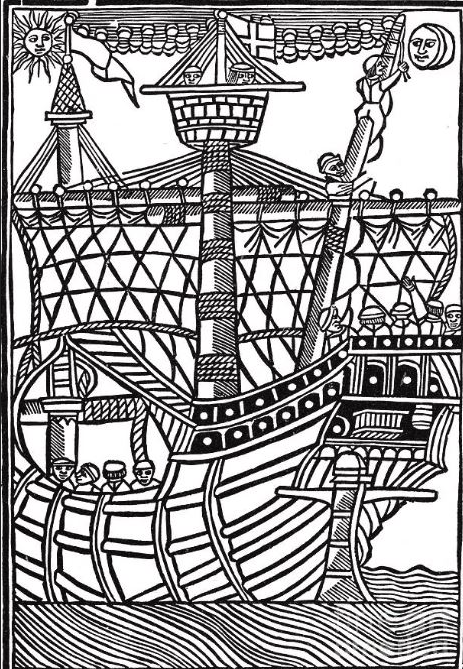

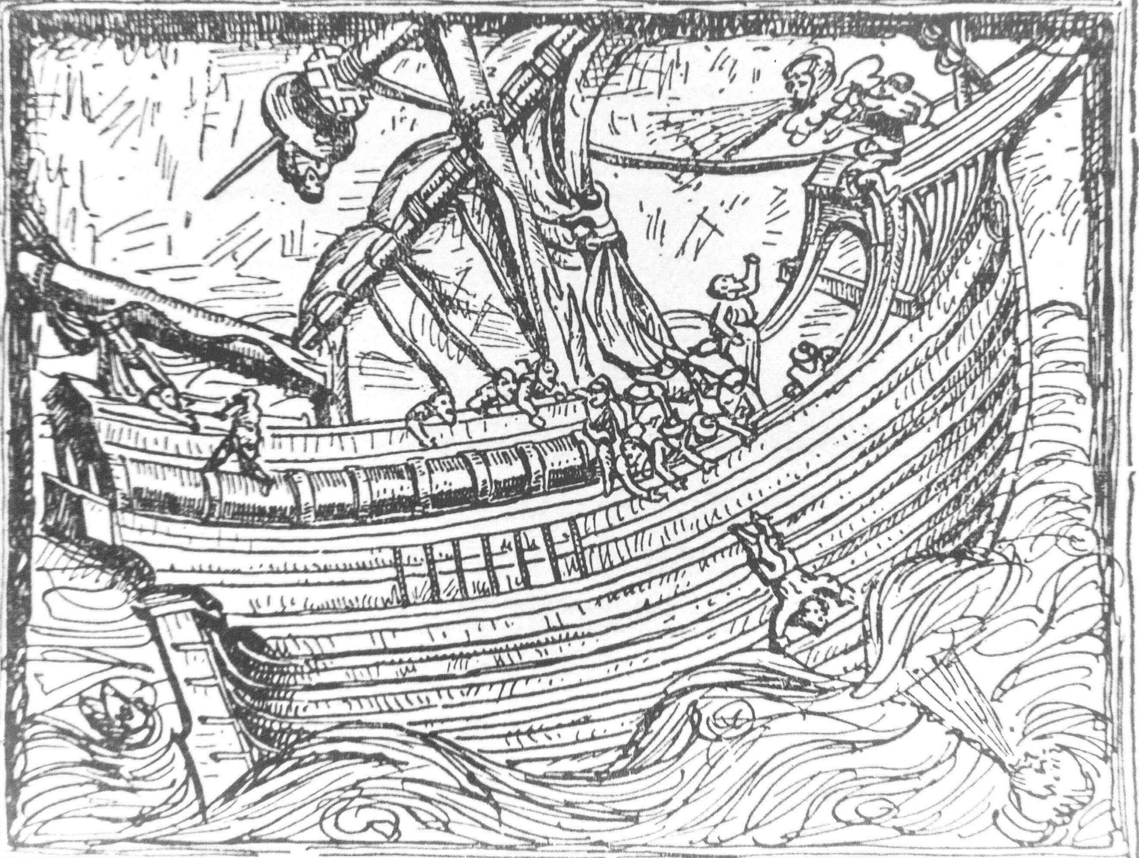

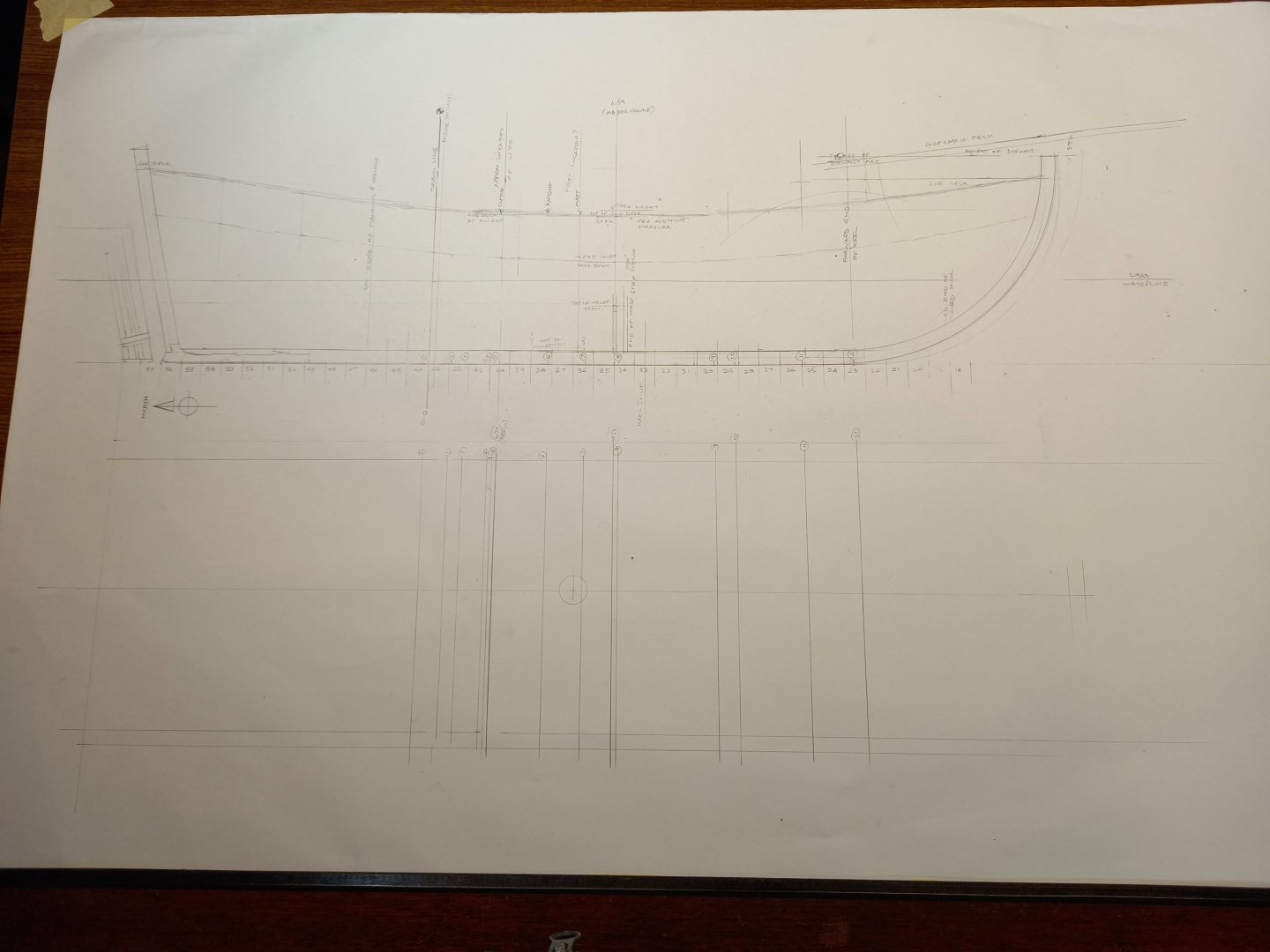
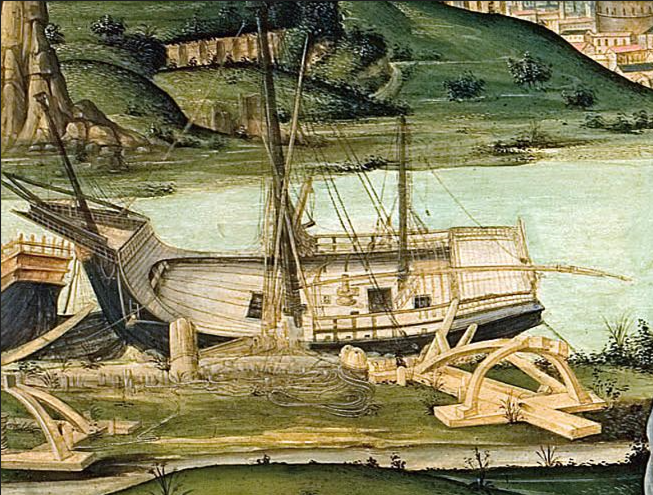
.thumb.jpg.0ea44d8c8bb556ada0eab86c9ea07e0e.jpg)
